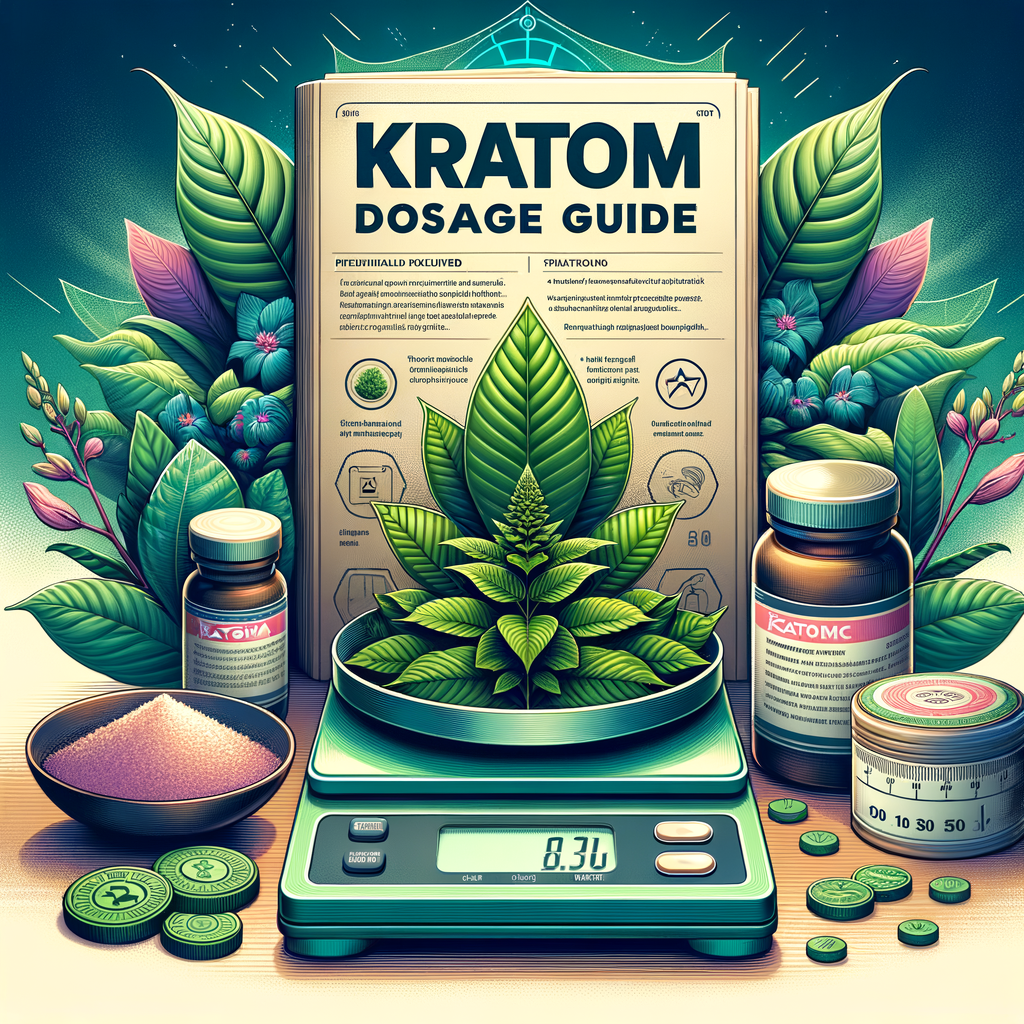
Kratom Dosage Guide: Must-Have Tips for Safe Use
- What is Kratom?
- Different Strains of Kratom
- The Importance of Dosage
- Recommended Dosage Range
- The Best Ways to Measure Kratom
- Advantages of Accurate Measurement
- Potential Side Effects and Risks
- How to Mitigate Side Effects
- Tips for First-Time Users
- Symptoms to Monitor
- The Role of Tolerance in Kratom Use
- Recognizing Tolerance Build-Up
- Managing Tolerance
- Combining Kratom with Other Substances
- Known Interactions
- Finding the Right Vendor
- The Legal Status of Kratom
- Staying Informed
- Conclusion
- FAQs
- 1. Is kratom safe to use?
- 2. How long does kratom take to work?
- 3. Can you develop a tolerance to kratom?
- 4. What should I do if I experience side effects from kratom?
- 5. Can I use kratom with other medications?
- 6. How should I store kratom?
- 7. Is there an age restriction for using kratom?
- 8. Can I travel with kratom?
- 9. What is the best strain for beginners?
- 10. Are there natural alternatives to kratom?
- References
Understanding Kratom Dosage: Must-Have Tips for Safe Use
Kratom has gained popularity as a herbal supplement, often used for its potential benefits, such as pain relief and mood enhancement. However, with this popularity comes the need for a thorough understanding of its dosage. Determining the right dosage is key to ensuring safety while maximizing benefits. In this guide, we’ll explore all aspects of kratom dosage, covering everything from the types of kratom to how to find the right amount for you.
What is Kratom?

Kratom, scientifically known as Mitragyna speciosa, is a tropical tree native to Southeast Asia. Its leaves have been used for centuries for their stimulating and sedative effects. Users often describe kratom as having a wide range of effects depending on the strain and dosage.
Kratom leaves contain several active compounds, notably mitragynine and 7-hydroxymitragynine. These compounds interact with opioid receptors, producing effects similar to morphine but varying significantly in intensity and experience. Understanding these differences can help users tailor their dosage effectively.
Different Strains of Kratom
Kratom is available in several strains, each offering different effects. The three primary colors of kratom strains are:
1. Red Strain: Known for its sedative and calming effects, red strains are often used for pain relief and relaxation.
2. Green Strain: Offering a balanced experience, green strains provide stimulation and mild pain relief without excessive sedation.
3. White Strain: This strain is popular for its energizing effects. Users report increased alertness and social interaction.
Each color represents a different alkaloid profile, influencing how kratom interacts with the body. Choosing the right strain is crucial for achieving the desired benefits.
The Importance of Dosage
When it comes to kratom, dosage plays a significant role in the overall experience. The right amount can lead to positive outcomes, while too little may yield no effects, and too much can lead to adverse reactions. Understanding how to balance dosage effectively can ensure you enjoy kratom safely.
A wide variety of factors can influence dosing recommendations, including:
– Body weight: Heavier individuals may require higher doses.
– Metabolism: Some people metabolize substances more quickly than others.
– Experience level: Beginners should start low and gradually increase their dosage.
– Strain: Different strains have varying potency levels.
Familiarizing yourself with these factors allows you to navigate dosing carefully.
Recommended Dosage Range
Finding the right dosage can feel overwhelming. However, most users find success within these general ranges:
– Beginners: 1 to 2 grams
– Moderate users: 2 to 5 grams
– Experienced users: 5 to 8 grams
– High doses: 8 to 10 grams ( caution advised)
Start with a lower dose, especially if you’re new to kratom. Gradually increase until you find the level that works best for you.
The Best Ways to Measure Kratom
Using accurate measurements can prevent overdosing and ensure a safe experience. Here are some reliable methods for measuring kratom:
1. Digital Scale: A precision scale can help you measure doses accurately down to the grams. Choose a scale that weighs small amounts accurately.
2. Scoop Measurements: If you don’t have a scale, you can use a teaspoon. Generally, one standard teaspoon holds approximately 2 to 3 grams of kratom, although this may vary depending on the strain’s density.
3. Pre-Measured Capsules: Many vendors sell kratom in capsule form with known dosages. These can simplify dose management for those who prefer convenience.
Advantages of Accurate Measurement
Measuring your kratom dose accurately has multiple benefits:
– Consistency: Accurate measurements ensure you know exactly how much you are taking each time.
– Safety: Avoiding high doses can reduce the risk of side effects or adverse reactions.
– Personalization: Consistent dosing allows for more effective experimentation with different strains and experiences.
By utilizing the right measuring methods, you can enjoy a more controlled and pleasant kratom experience.
Potential Side Effects and Risks
Though kratom is considered safe when used responsibly, it can lead to several side effects, particularly with high doses. Some common effects include:
– Nausea and vomiting
– Dizziness and lightheadedness
– Constipation
– Increased heart rate
– Sedation (especially with red strains)
Long-term use of kratom may also lead to dependency, and withdrawal symptoms can occur upon cessation. It’s vital to monitor your intake and consult a healthcare provider if you experience any adverse effects.
How to Mitigate Side Effects
You can take several steps to help reduce the risk of side effects while using kratom:
1. Stay Hydrated: Drink plenty of water, as kratom can lead to dehydration, which may exacerbate some side effects.
2. Use Lower Doses: Start small and increase gradually, allowing your body to adjust to the compounds.
3. Take Breaks: Regularly cycling on and off kratom can help prevent dependency and reduce tolerance buildup.
4. Monitor Effects: Keep a journal of your experiences with different doses and strains. This will help you understand what works best for you.
Taking these measures can increase the likelihood of a positive experience with kratom.
Tips for First-Time Users
If you’re considering trying kratom for the first time, here are some essential tips:
1. Research: Familiarize yourself with the different strains and their effects. Understand what you might be looking for, whether it’s pain relief, energy, or relaxation.
2. Start Small: Your first dose should never exceed 2 grams. This allows you to assess how your body reacts without overwhelming your system.
3. Choose Quality Products: Purchase kratom from reputable vendors who provide lab-tested products. Quality matters.
4. Stay in a Safe Environment: If possible, try kratom when you can relax. This will help you concentrate on how it affects you.
5. Be Patient: It might take time to find the perfect strain and dose that works for you, so don’t rush the process.
These tips will help ensure your initial experience with kratom is safe and enjoyable.
Symptoms to Monitor
As a new user, pay attention to how your body reacts. Here are symptoms to keep an eye on:
– Unusual drowsiness or fatigue
– Changes in heart rate
– Nausea or gastrointestinal distress
If you notice these symptoms, consider reducing your dose or switching strains. If symptoms persist, stop using kratom and consult a healthcare professional.
The Role of Tolerance in Kratom Use
Like many substances, regular kratom use can lead to tolerance, requiring higher doses to achieve the same effects. This phenomenon occurs because the body becomes accustomed to compounds over time. Understanding tolerance can help you make informed decisions about your kratom use.
Recognizing Tolerance Build-Up
You might notice tolerance if you find that:
– Your usual dose no longer provides the desired effects.
– You start taking larger amounts than in the past.
– You experience diminished satisfaction from kratom.
Recognizing these signs early enables you to manage your consumption effectively.
Managing Tolerance
Here are a few strategies for managing tolerance to kratom:
1. Take Regular Breaks: Periodic breaks from kratom can help reset your tolerance levels.
2. Rotate Strains: Switch between different strains to reduce the likelihood of tolerance formation.
3. Lower Doses: Gradually decrease your dosage for a while to help reset your body’s response.
These methods can help maintain kratom’s effectiveness while minimizing adverse effects associated with high doses.
Combining Kratom with Other Substances
You may wonder what happens if you mix kratom with other substances. It is crucial to be cautious, as combining kratom with other drugs or supplements can lead to unpredictable results. While some people do combine kratom with substances like CBD or other herbal supplements, the interactions can vary widely.
Known Interactions
– Alcohol: Mixing kratom with alcohol can increase sedation and impair motor functions.
– Caffeine: The stimulant effects of caffeine may amplify kratom’s stimulating properties, leading to increased heart rate or anxiety.
– Opioids: If you’re using kratom to manage pain alongside opioids, be cautious. Combining these can heighten side effects and dependency risk.
Always consult a healthcare professional before mixing kratom with any substance to ensure safety.
Finding the Right Vendor
When purchasing kratom, selecting a reputable vendor is critical. Here are factors to consider:
1. Lab Testing: Check if the vendor provides lab-tested products to ensure purity and quality.
2. Customer Reviews: Look at reviews and feedback from previous users to gauge product quality and customer service.
3. Transparent Information: A reliable vendor should provide clear details about strain specifics, sourcing, and dosage recommendations.
Choosing the right vendor can make a significant difference in your kratom experience.
The Legal Status of Kratom
Kratom’s legal status varies by location. In some areas, it remains legal and widely available, while in others, it may be banned or regulated. Always check your local laws before purchasing or consuming kratom. Understanding the legal landscape can help you avoid potential pitfalls.
Staying Informed
Stay updated on changes in kratom legality. Many organizations advocate for kratom’s safe use and are working towards regulation rather than prohibition. Familiarizing yourself with activism and joining discussions can keep you informed about ongoing legislative changes.
Conclusion
Navigating kratom dosage requires careful attention and knowledge. By understanding strains, creating an accurate dosing routine, and monitoring effects, you can enjoy the benefits of kratom safely. Whether you are looking for relief from pain, increased energy, or relaxation, you can find a suitable approach that meets your needs. Remember to prioritize safety and consult with a healthcare provider if you have concerns.
FAQs
1. Is kratom safe to use?
Kratom is generally safe for most users when taken responsibly. However, improper use can lead to side effects.
2. How long does kratom take to work?
Effects typically start within 20 to 60 minutes after ingestion, depending on the method and dosage.
3. Can you develop a tolerance to kratom?
Yes, regular use can lead to tolerance, requiring higher doses for the same effects.
4. What should I do if I experience side effects from kratom?
If you experience side effects, consider reducing your dose or stopping use altogether. Consult a healthcare provider if symptoms persist.
5. Can I use kratom with other medications?
Consult a healthcare professional before combining kratom with other medications to avoid potential interactions.
6. How should I store kratom?
Store kratom in a cool, dark, and dry place to maintain its potency and freshness.
7. Is there an age restriction for using kratom?
Many vendors require users to be at least 18 years old. However, legality varies by location.
8. Can I travel with kratom?
Check the legal status of kratom in your destination, as some areas have restrictions or bans.
9. What is the best strain for beginners?
You may want to start with a green strain, as it often offers balanced effects.
10. Are there natural alternatives to kratom?
Yes, there are other herbal supplements, such as CBD or kava, that may offer similar effects. Research each thoroughly before use.
References
1. National Institute on Drug Abuse. (2021). “Kratom’s Effect on the Brain.” Link
2. Harvard Health Publishing. (2020). “Kratom: What to Know.” Link
3. American Kratom Association. (2023). “Kratom Use: Safety and Efficacy.” Link
4. Mayo Clinic. (2022). “Kratom: A Guide to Use and Risks.” Link


